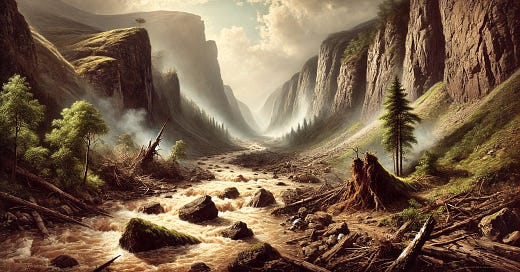The Great Flood of 1829, often referred to in Scotland as the "Muckle Spate," was a cataclysmic event that left an indelible mark on the Scottish Highlands. While its devastation spread across much of the northeast, few places illustrate its transformative power more dramatically than Glen Quoich. Once a serene glen where the Quoich Water flowed gently into the Dee, the flood reshaped its landscape, submerged historical landmarks, and created features still visible today. This is the story of how Glen Quoich was irrevocably changed in one fateful night.
A Prelude to Chaos: Glen Quoich Before the Flood
Before the flood, Glen Quoich was a picturesque part of the Braemar Highlands. Its defining feature, the Quoich Water, carved a charming path through the glen, forming the famed "Linn of Quoich." This narrow gorge, barely three feet across at its start, was a marvel of natural engineering, with its waters tumbling over rocks and hollowing out the "Cniach," or goblet-shaped depressions in the gneiss. One particularly large cavity, known as the "Earl of Mar's Punch Bowl," had become a favorite of locals and visitors.
The glen also boasted fertile plains and woodlands. The land near the mouth of Glen Quoich, known as the Creggins, supported a small community. The area was alive with human activity, and legends of past battles—such as the fall of Semus-na-Gruaig, the Laird of Rothiemurchus—imbued the landscape with a sense of history.
But all of this would change in the early hours of August 4, 1829.
The Deluge: A Night of Unimaginable Power
The summer of 1829 had been wet, with heavy rainfall saturating the soil and swelling rivers. By early August, the ground could absorb no more, and an unprecedented storm unleashed torrents of rain upon the Highlands. Braemar and its surrounding glens bore the brunt of the storm's fury, as rivers and streams transformed into raging torrents.
The Quoich Water was no exception. Its narrow linn, usually a peaceful site for meditation, became a bottleneck for the roaring floodwaters. Trees were uprooted and swept into the gorge, creating natural dams that caused the water to surge and cascade violently over the barriers. As the river swelled beyond its banks, it tore through the Creggins, reducing fertile plains to a swampy wasteland.
Eyewitness accounts describe the scene as apocalyptic. Boulders the size of cottages were dislodged and hurled downstream, reshaping the riverbed and its surroundings. The floodwaters carried away entire trees, livestock, and debris from homes. The powerful currents submerged much of the lairdship of the Creggins, erasing its historical footprint in one devastating sweep.
The Aftermath: A New Glen Quoich Emerges
When the waters finally receded, Glen Quoich was unrecognizable. The landscape bore the scars of the flood in ways both subtle and dramatic:
The Transformation of the Linn
The Linn of Quoich, once a narrow, picturesque gorge, had been widened and deepened by the relentless force of the water. The famous Cniach formations had been altered, with some destroyed entirely. The Earl of Mar’s Punch Bowl survived but bore new markings from the flood’s abrasion.The Loss of the Creggins
The fertile plains of the Creggins were buried under layers of silt, gravel, and debris. Trees that once stood tall on the plain were now scattered like matchsticks, and the area became a marshland. Attempts to recover the land were largely futile, and the Creggins became a ghostly reminder of the flood’s power.Changes to the River Dee
At the mouth of Glen Quoich, the floodwaters spilled into the Dee, depositing massive amounts of sediment and creating new channels. The Dee's course was permanently altered in some areas, and the surrounding strath bore evidence of widespread erosion.Cultural and Economic Impact
The flood devastated not only the landscape but also the people of Braemar. Entire families were displaced, and centuries-old settlements were abandoned. The loss of fertile land and the destruction of infrastructure left a lasting economic impact on the region.
Echoes of the Flood: Glen Quoich Today
Today, the effects of the flood can still be observed in Glen Quoich. The Linn remains a popular destination, its rugged beauty a testament to nature's power. The Earl of Mar’s Punch Bowl continues to intrigue visitors, its resilience adding to its mystique. However, the history of the Creggins is now largely forgotten, buried under layers of sediment and time.
For locals and historians, the Great Flood of 1829 serves as a poignant reminder of the Highlands' vulnerability to natural forces. It also highlights the region’s resilience, as the landscape and its people have adapted and thrived in the years since.
Conclusion
The Strange Flood of 1829 was not merely an event—it was a turning point for Glen Quoich and the surrounding Braemar Highlands. It reshaped the land, destroyed communities, and etched a story of destruction and rebirth into the history of the region.





